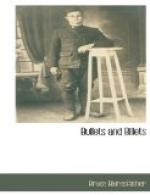We made a very excellent and strong emplacement on the road, and used it henceforth. I had a lot of bother with one gun in those trenches, which was placed at very nearly the left-hand end of the whole line. I had been obliged to fix the gun there, as it was very necessary for dominating a certain road. But when I took the place over from the previous battalion, I thought there might be difficulties about this gun position, and there were. The night before we had made our inspection of these trenches, a shell had landed right on top of the gun emplacement and had “outed” the whole concern, unfortunately killing two of the gun section belonging to the former battalion. For some reason or other that end of our line was always being shelled. Just in the same way as they plunked shells daily into St. Yvon, so they did here. Each morning, with hardly ever a miss, they shelled our trenches, but almost invariably in the same place: the left-hand end. The difference between St. Yvon and this place was, however, that here they always shelled with “heavies.” Right back at the Douve farm a mile away, the thundering crash of one of these shells would rattle all the windows and make one say, “Where did that one go?”
All round that neighbourhood it seemed to have been the fashion, past and present, to use the largest shells. In going along the Douve one day, I made a point of measuring and examining several of the holes. I took a photograph of one, with my cap resting on one side of it, to show the relative proportion and give an idea of the size. It was about fourteen feet in diameter, and seven feet deep. The largest shell hole I have ever seen was over twenty feet in diameter and about twelve feet deep. The largest hole I have seen, made by an implement of war, though not by a gun or a howitzer, was larger still, and its size was colossal. I refer to a hole made by one of our trench mortars, but regret that I did not measure it. Round about our farm were a series of holes of immense size, showing clearly the odium which that farm had incurred, and was incurring; but, whilst I was in it, nothing came in through the roof or walls. I have since learnt that that old farm is no more, having been shelled out of existence. All my sketches on those plaster walls form part of a slack heap, surrounded by a moat.




